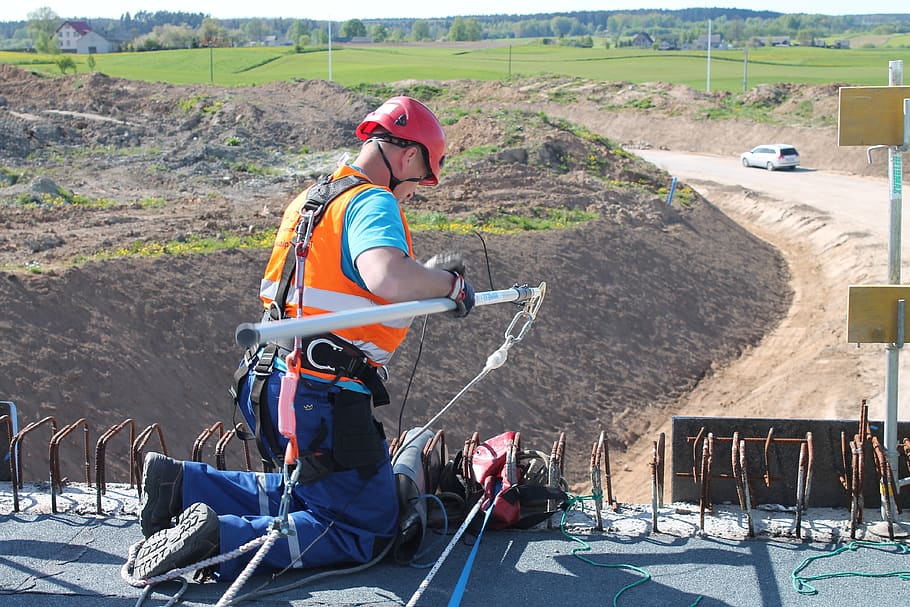Work at height rescue plan
Contents |
[edit] Introduction
The Work at Height Regulations (2005) define work at height as:
- work in any place, including a place at or below ground level;
- obtaining access to or egress from such place while at work, except by a staircase in a permanent workplace;
where, if measures required by the regulations were not taken, a person could fall a distance liable to cause personal injury.
The regulations impose duties on:
[edit] Rescue plan overview
Where work at height is necessary (typically when fall arrest systems are in use), duty holders are required by law to ensure that work at height is properly planned and organised. This means duty holders are obliged to have a rescue plan in place, which ensures that a worker can be retrieved as soon as possible if a fall occurs.
A rescue plan is a pre-planned procedure designed to safely retrieve someone who has fallen from height and is in a potentially dangerous position. The plan provides information about the type and location of rescue equipment that is vital in the rescue process.
The Health and Safety Executive suggests duty holders make several considerations in their plans, including:
- What will be the anchor point for the safety equipment?
- What type of weather could compromise worker safety?
- Will the rescuers be safe when carrying out the procedure?
- Is the equipment the individual was using no longer safe?
- How will the individual be attached to the rescue kit once they are reached?
- How will they be moved once the rescue team reaches them?
[edit] Competent rescuers
During work at height rescue situations, emergency rescue arrangements should not rely on the fire brigade or emergency services. Waiting for emergency services may be critical, and it is not their duty to rescue a fallen worker.
The Work at Height Regulations 2005 state that all activities, including the rescue, are the responsibility of the employer and should be carried out promptly by competent people within the organisation who fully understand the plan. Potential rescuers should be screened for sufficient skills and experience to perform rescue operations.
Rescue typically involves the recovery of a casualty by another person either remotely or directly. This differs from an evacuation, which is typically carried out by a stranded user to escape from a remote situation such as a tower crane.
Carrying out rescues and the use of rescue equipment requires technical capability in addition to the ability to use personal fall protection. There are also specialised rescue kits designed for extreme cases in which a rescuer needs to be lowered head-first into a confined space to perform a rescue. Regular training may be required for the designated rescuer to maintain competence in these types of systems.
[edit] Related articles on Designing Buildings
- Competent person.
- CONIAC produces essential messages on safe work at height.
- Fall prevention systems.
- Health and Safety.
- Injuries on construction sites.
- Work at height.
- Work at height checklist for managers.
- Work at height regulations.
- Working at height - our duty to prevent harm and protect each other.
- Working at height training.
[edit] External resources
Featured articles and news
Latest Build UK Building Safety Regime explainer published
Key elements in one short, now updated document.
UKGBC launch the UK Climate Resilience Roadmap
First guidance of its kind on direct climate impacts for the built environment and how it can adapt.
CLC Health, Safety and Wellbeing Strategy 2025
Launched by the Minister for Industry to look at fatalities on site, improving mental health and other issues.
One of the most impressive Victorian architects. Book review.
Common Assessment Standard now with building safety
New CAS update now includes mandatory building safety questions.
RTPI leader to become new CIOB Chief Executive Officer
Dr Victoria Hills MRTPI, FICE to take over after Caroline Gumble’s departure.
Social and affordable housing, a long term plan for delivery
The “Delivering a Decade of Renewal for Social and Affordable Housing” strategy sets out future path.
A change to adoptive architecture
Effects of global weather warming on architectural detailing, material choice and human interaction.
The proposed publicly owned and backed subsidiary of Homes England, to facilitate new homes.
How big is the problem and what can we do to mitigate the effects?
Overheating guidance and tools for building designers
A number of cool guides to help with the heat.
The UK's Modern Industrial Strategy: A 10 year plan
Previous consultation criticism, current key elements and general support with some persisting reservations.
Building Safety Regulator reforms
New roles, new staff and a new fast track service pave the way for a single construction regulator.
Architectural Technologist CPDs and Communications
CIAT CPD… and how you can do it!
Cooling centres and cool spaces
Managing extreme heat in cities by directing the public to places for heat stress relief and water sources.
Winter gardens: A brief history and warm variations
Extending the season with glass in different forms and terms.
Restoring Great Yarmouth's Winter Gardens
Transforming one of the least sustainable constructions imaginable.























